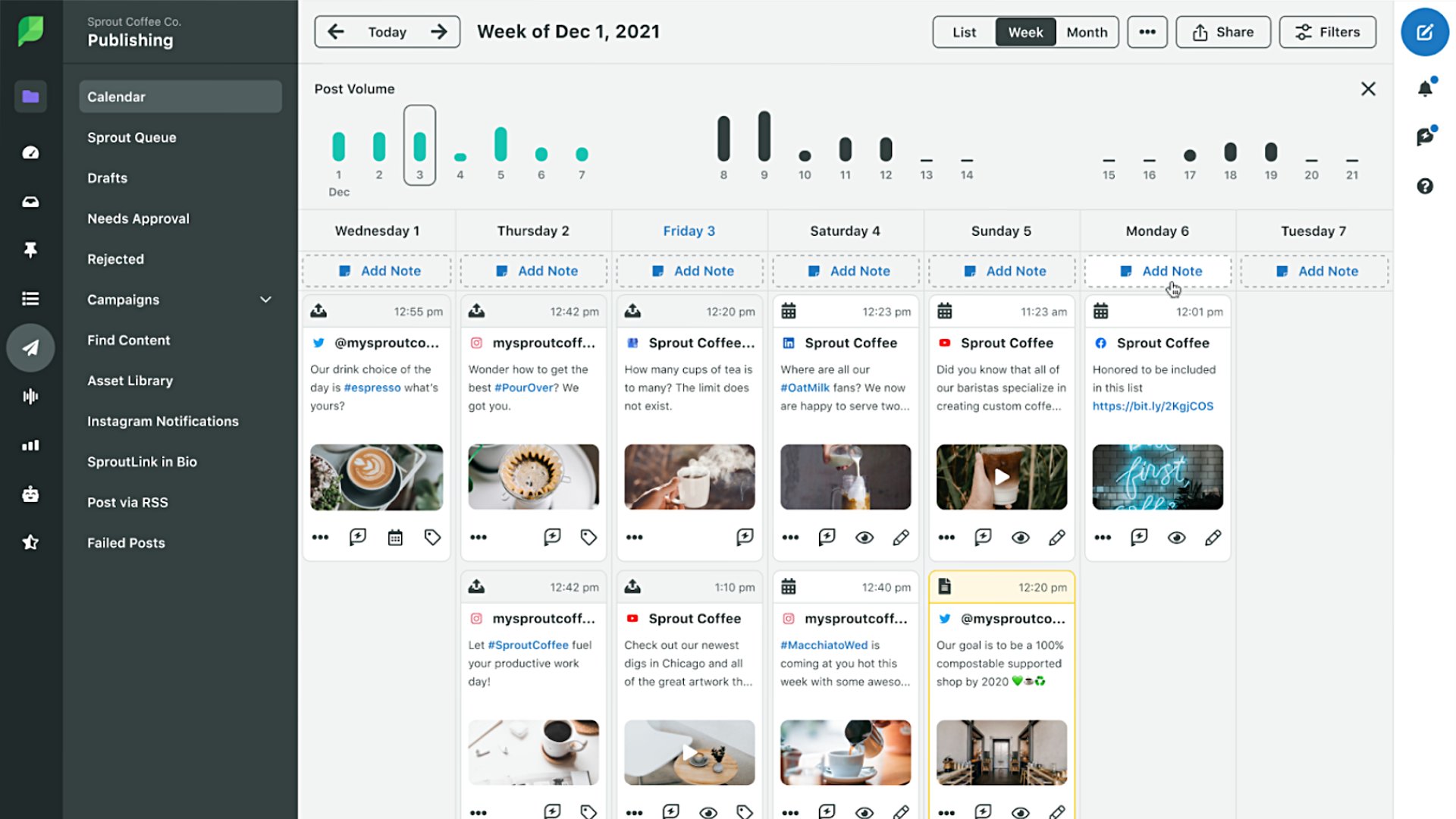Social media personalisation at scale: A 2025 guide for UK ecommerce
Table of Contents
Social media personalisation isn’t just a nice-to-have in 2025—it’s the bare minimum for connecting with UK shoppers who expect relevance, speed and emotional resonance.
According to the Sprout Social Index™ 2025, consumers are most likely to engage with brands that understand their needs and speak to them directly. That’s where personalisation becomes your competitive edge.
Read on to discover how leading UK ecommerce brands use social personalisation to increase engagement, boost social media ROI and turn social data into smarter decisions—and how to implement the same strategies using Sprout.
What is social media personalisation for ecommerce and retail?
Social media personalisation involves strategically using audience data to tailor content, offers and messaging for specific audience segments so every touchpoint feels timely, relevant and intentional. It’s how brands deliver genuine value by aligning social content with people’s behaviours, interests and position in the buyer journey.
For UK retailers in 2025, personalisation is no longer optional. As social platforms increasingly prioritise relevance in their algorithms, brands that personalise are the ones that stay visible. In its 2025 Consumer Trends Index report, Marigold, a relationship marketing platform, found that 45% of consumers felt frustrated when they received content and offers that weren’t relevant to them. This signals a missed opportunity for brands to earn consumer trust and drive brand loyalty through personalised content.
Rather than just plugging names into messages or post captions, this strategy involves using real-time insights and tools like conversational AI and machine learning to shape meaningful experiences across every platform. Marigold’s 2025 Consumer Trends Index also found that AI-generated dynamic offers and personalised product recommendations are two methods that consumers appreciate.
With the right strategy and tool kit, social teams can move from guesswork to precision, making personalisation both scalable and strategic.
Why personalisation matters for UK ecommerce brands
Personalisation isn’t just about connection—it also drives real business outcomes. For UK brands, a social-first approach to personalisation unlocks measurable gains across engagement, performance and agility.
Here are three specific benefits for UK-based brands:
1. Increased engagement and loyalty
In the UK and worldwide, shoppers respond to content that resonates with their personal needs and interests. In fact, Deloitte found that businesses that offer personalised customer experiences are 71% more likely to increase their customer loyalty.
That means going beyond generic posts for campaigns like Black Friday. A beauty retailer, for instance, might promote skin care tips that vary by age group or climate—think SPF in Brighton and moisturisers in Edinburgh. With Sprout’s unified inbox and engagement tools, brands can manage these one-to-one interactions efficiently and stay responsive across channels.
Brand love doesn’t happen overnight, and it doesn’t last without effort. When you create personalised experiences across social, you build stronger, longer-term relationships grounded in relevance and trust.
2. Improved campaign performance across platforms
Tailored content drives action, not just attention. As part of an omnichannel marketing strategy, McKinsey found in 2021 that consumers are 76% more likely to purchase from brands with personalised content. Additionally, consumers are 78% more likely to recommend or make a repeat purchase from those brands, respectively.
A consistently personalised brand experience boosts recognition, conversion rates and retention, essential when social media fatigue is an additional challenge for marketers. It also turns loyal customers into advocates. That leads to more user-generated content (UGC) and richer sentiment data, which gives you the insight you need to expand your reach and strengthen future social media marketing campaigns.
Sprout tip: Sprout’s publishing and reporting workflows make it easy to test and refine messaging across platforms like Instagram, TikTok, LinkedIn and Facebook. For instance, if you want to test a visual-heavy ad for younger Gen Z audiences while refining a value-led message for older segments, Sprout helps you scale quickly and precisely.
3. More actionable social data
Think of social like a real-time focus group: Comments, mentions and DMs surface what customers really think about your pricing, delivery experience or product quality.
Sprout tip: Sprout turns that feedback into insight with its Social Listening feature. Features like tagging and sentiment analysis also help you detect emerging trends, understand audience sentiment across the customer journey and act quickly—whether you’re adjusting a promotion, planning a restock or refining your product messaging. When social data becomes decision fuel, teams will be more agile and customer-centric.
How to personalise your social media presence
Personalisation is an ongoing process based on data and audience needs, not a single tactic. Here are some ways to scale it with Sprout while keeping your content relevant, efficient and grounded in real-time data:
Audit your existing social content
Before you optimise your personalised marketing strategy, you need to know what’s already working.
With social media analytics tools, you can break down performance by audience segment to understand how different age groups, regions or customer types engage. That way, you can spot the patterns, cut what’s not landing and scale the content that actually resonates.
Real-world example: Greggs has long known that its target audience appreciates irreverent, self-aware humour, and it leans into this consistently. Whether it’s by sharing custom memes that tap into early-2000s nostalgia or repurposing common social acronyms like GTG (Going to Greggs), the brand connects with its audience through content they appreciate.
With the right data-driven insights, brands can follow suit, using social data to shape creative that entertains and engages.
Source: Instagram
Identify crucial audience segments
Go beyond demographics by using a social media listening tool to uncover behavioural insights, interests and common customer pain points. Then, layer in customer data from platforms like Salesforce or HubSpot to segment by lifecycle stage or purchase history.
The result? Precision messaging that feels personal at every touchpoint.
Real world example: LOOKFANTASTIC consistently personalises its beauty content by skin type, product use and audience interest. On Instagram, it uses Stories and polls to spark two-way conversations, then refines product bundles based on the feedback.
Source: Instagram
Apply AI-powered data analysis
AI automation tools can eliminate guesswork by highlighting trending topics, questions and sentiment shifts. This helps social teams understand what matters most to each audience segment and react with smarter, more resonant content.
Real-world example: ASDA’s launch of its Stitch (from Disney’s Lilo & Stitch) range wasn’t a shot in the dark—previous sentiment analysis had flagged strong shopper interest in Disney products. Engagement metrics and audience sentiment on its Instagram announcement confirmed that ASDA’s customers couldn’t get enough.
Source: Instagram
Automate publishing
Customisation doesn’t have to slow you down. Sprout’s Publishing tools—including Optimal Send Times (which pinpoint the best time to post your social content), Custom Post Variables and Approval Flows—let you deliver targeted content at scale while protecting your team’s time and brand voice.

Measure and optimise
As your audience evolves, your strategy needs to keep up too.
Having robust social media analytics tools really matters for personalisation at this level. Because of this, you should be tracking social media engagement, customer interactions and audience sentiment over time by segment. This data results in continuous feedback loops, better message-market fit and stronger performance across every platform.
Real-world example: IRN-BRU fans are never short of opinions—and the brand embraces it. Video reactions like this one give IRN-BRU a real-time read on how audiences feel about new flavours, which helps the brand track sentiment and shape future launches with confidence.
Source: TikTok
Make personalisation your social strategy
While metrics may track success, it’s personalisation that truly helps UK brands earn trust and long-term loyalty. When you combine rich audience insights with automation and real-time feedback, every post becomes more impactful.
Ready to turn your social data into deeper customer connections at scale? Start a free trial of Sprout Social today.
FAQs about social media personalisation
How can I personalise my brand’s social media?
To personalise your social media, you can align content with your audience’s behaviours, preferences and moments that matter.
Sprout’s Smart Inbox and Profile Performance Reports make it easy to pinpoint what resonates across each network. For instance, you can use tags to track performance by campaign or audience segment and optimise based on what’s actually driving results.
With Sprout’s Optimal Send Times, you can publish when your UK audience is most likely to engage. And with Listening, you’ll spot local trends and sentiment shifts as they happen so your content stays timely, relevant and rooted in what your community cares about.
How do I measure personalised marketing efforts
You can track personalised marketing by measuring engagement, conversions and content performance by audience segment or campaign.
Sprout’s Premium Analytics allow you to build tailored dashboards that align with specific goals, like ROI by network or campaign effectiveness. Then, with Tag Performance Reports, you can compare personalised and generic content side by side, then double down on what drives results.
How do retargeting ads improve personalised digital experiences?
Retargeting ads enhance personalisation by serving timely, relevant follow-ups based on your audience’s previous interactions. They reconnect your brand with people who’ve engaged, whether they clicked a post, watched a video or visited your site, and move them closer to action.
With Sprout’s integrations, you can build smarter audience segments using social data to ensure that your ads land at the right moment. Then, layer in Sprout Social Influencer Marketing to align creator content with your retargeting strategy. This strengthens trust and drives conversions that feel organic, not forced.
How can I balance data privacy while personalising my customer experiences?
You can balance personalisation with privacy by using the insights your audience shares publicly, like engagement trends, sentiment and social conversations, instead of relying on personal user data.
Sprout’s Listening and Reporting tools help with this by spotting meaningful patterns without invasive tracking or third-party cookies.
By segmenting content based on interest or intent, not individuals’ identities, you can stay compliant with UK GDPR and EU data regulations while delivering relevant, human experiences. This trust-first approach proves that you don’t need to compromise privacy to create impact.






Share